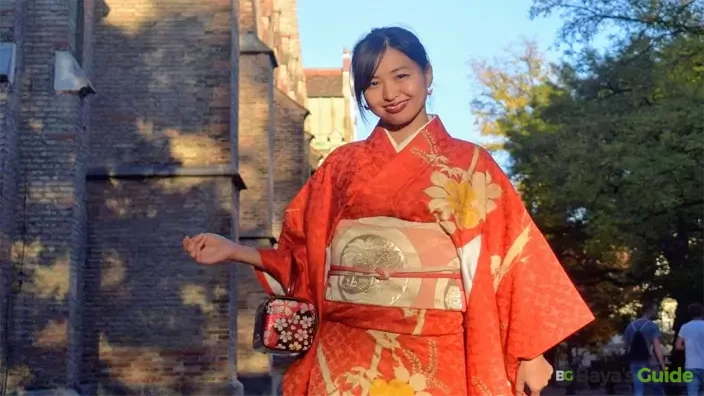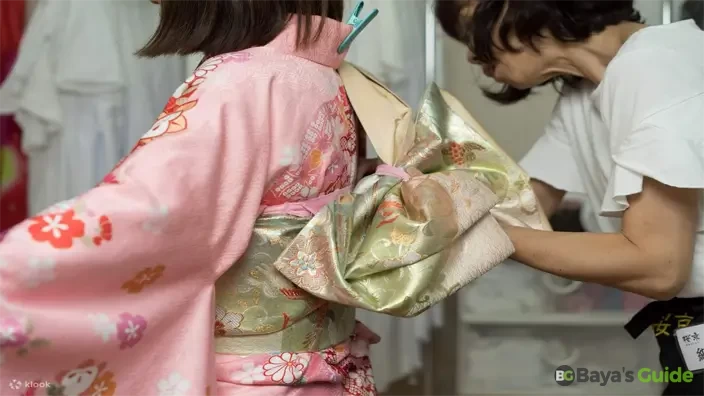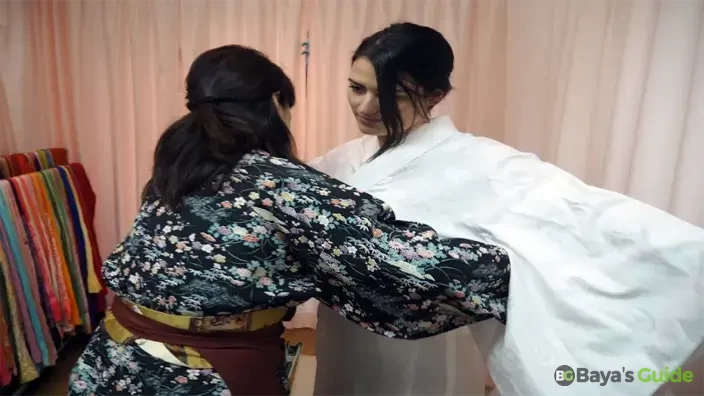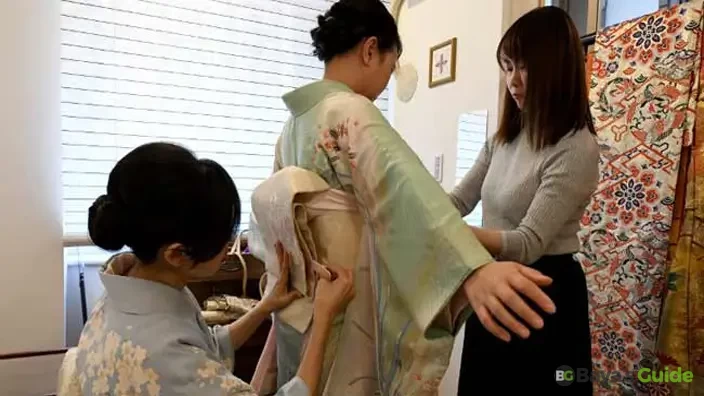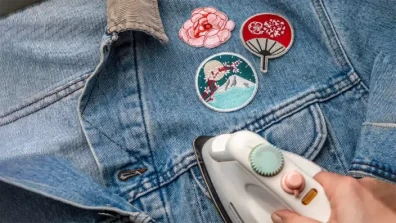Putting on kimono and yukatas might be vexatious but that challenge doesn’t stop you from wearing it. Though the modern Japanese have taken on a Western style of clothing the Japanese kimono is considered the symbol of honor at various occasions like graduations, official gatherings, private ceremonies, or most particularly weddings.
The kimono, a traditional Japanese garment renowned for its exquisite craftsmanship and timeless elegance, encapsulates centuries of cultural richness and sartorial finesse. Wearing a kimono is not just about donning a piece of clothing; it is an art form, a celebration of heritage, and a reflection of grace. In this guide, we embark on a journey to demystify the intricacies of wearing a kimono, exploring the layers of meaning woven into each fold and tie.
From the selection of fabrics and patterns to the meticulous art of draping, we delve into the essence of this iconic garment, providing insights that extend beyond mere fashion tips to embrace cultural significance and respect for tradition. Whether you are an enthusiast seeking to master the art of donning a kimono or someone intrigued by the allure of Japanese fashion, this guide invites you to step into a world where elegance and style converge in the mesmerizing folds of a kimono.
Table of Contents
- Essential Elements Of Kimono Dressing
- Must-Have Components For Kimono Dressing
- Elevate Your Kimono Look: Must-Have Accessories
- Graceful Attire: How to Wear a Kimono with Elegance
- Step 1: Putting On Tabi Socks
- Step 2: The Traditional Undergarments
- Step 3: Wrap Right Over Left
- Step 4: Adjust Shoulders
- Step 5: Secure Obi
- Step 6: Fold Collar
- Step 7: Check Sleeve Length
- Step 8: Smooth The Fabric
- Step 9: Put On The Nagajuban
- Step 10: Put On The Kimono
- Step 11: Tie The Kimono In Place
- Step 12: Arrange The Collars
- Elevate Your Look: Kimono & Jeans Styling For Petite Frames
- Wearing Kimono Right: Common Pitfalls To Avoid
- Frequently Asked Questions
- Conclusion
Essential Elements Of Kimono Dressing
In Japan, most people rent kimonos on different occasions at many used kimono shops as they findinexpensive souvenirs. The major problem is with the people who rent or purchase the kimono from the fabric shop but after coming back home, they get confused about how to wear it. In this article, we have taken help from kimono expert Sheila Cliffe and model Nichole (Instagram @nfkimono) to write tips about the items and process required to put on a woman's kimono properly and also demonstrate while wearing and after wearing it by yourself.
Must-Have Components For Kimono Dressing
Several types of accessories and items of clothing are necessary garments for wearing a women's kimono, but some other items are optional only for the ornamenting of the costume starting from undergarments to outward clothing layers per the demonstration of Sheila.
Wearing a traditional Japanese kimono involves several components, each carefully chosen to create a harmonious and culturally significant ensemble. Here's what you need to wear a kimono:
1- Kimono (着物)
The central piece, the kimono itself, is a T-shaped garment with straight seams and wide sleeves. Kimonos come in various styles, lengths, and colors, each serving specific occasions or seasons.
2- Obi (帯)
The obi is a wide, decorative sash that cinches the kimono at the waist. It plays a crucial role in overall aesthetics and is often tied in intricate knots. Different occasions call for specific obi styles.
3- Nagajuban (長襦袢)
Worn underneath the kimono, the nagajuban is a white undergarment resembling a full-length slip. It provides a smooth surface for the kimono and helps in absorbing perspiration.
4- Tabi (足袋)
Tabi are traditional split-toe socks worn with zori sandals. They ensure comfort while wearing traditional Japanese footwear.
5- Zori OR Geta (草履 OR 下駄)
Zori are flat sandals with a thong strap, while geta are elevated wooden sandals. The choice between zori and geta depends on the formality of the occasion.
6- Koshihimo (腰紐)
Koshihimo are long, thin cords used to secure the kimono in place before adding the obi. They are tied around the body to create the desired silhouette.
7- Han'eri (半襟)
A decorative collar or han’eri is attached to the nagajuban and peeks out from the neckline of the kimono. It adds a touch of color and elegance to the overall look.
8- Erandi (絵襟)
Some kimonos may feature an additional decorative collar called erandi. This is attached to the kimono collar and serves a similar purpose as the han’eri.
9- Kanzashi (簪) OR Hair Ornaments
Kanzashi, traditional Japanese hair ornaments, can be worn with a kimono. They come in various designs and materials, complementing the overall look.
Explore More:How To Hang A Heavy Picture
Elevate Your Kimono Look: Must-Have Accessories
Optional accessories like a decorative cord known as obijime, obiage (a scarf-like accessory), and traditional Japanese jewelry can be added for extra flair.
Note: It's important to note that the specific components and their designs may vary based on the formality of the occasion, the season, and personal preferences. Learning to properly wear a kimono is a skill that involves understanding the nuances of each element and appreciating the cultural significance behind this iconic attire.
Graceful Attire: How to Wear a Kimono with Elegance
You can't dress yourself in a kimono on the first try, you need practical practice to put on the kimono. By following the given steps, you will be ready to dress yourself up in a kimono costume by experiencing wearing it by yourself. No need to let you know to wear undergarments such as a bra and women’s briefs before you begin.
Step 1: Putting On Tabi Socks
This is the first and foremost step which is often overlooked while wearing a kimono. Wearing tabi socks after you have completely dressed up in a kimono costume is quite tricky as it increases the risk of splitting down some of the other fabrics from the place you have wrapped yourself with. It’s great to wear tabi socks to avoid the chance of bending while wearing them.
Step 2: The Traditional Undergarments
Wearing traditional undergarments like juban and hadajuban is customary before putting on a kimono in Japanese attire etiquette. First, you should wear susoyoke (or long johns) and hadajuban in the center while keeping your back neck open. Avoid tucking your hadajuban inside the susoyoke as it makes jumbled up.
Ensure your juban (under-kimono) and hadajuban (undergarment for the lower body) are worn correctly, with the juban collar visible at the top.
Step 3: Wrap Right Over Left
As you put on the kimono, wrap the right side over the left, creating a neat and smooth front.
Step 4: Adjust Shoulders
Make sure the kimono sits evenly on your shoulders. The shoulder seam should be straight and the sleeves symmetrically falling.
Step 5: Secure Obi
Tie the obi (wide belt) firmly around your waist, covering the junction where the two sides of the kimono meet. This helps create a tidy appearance.
Step 6: Fold Collar
Fold the collar neatly and adjust its width according to the formality of the occasion.
Step 7: Check Sleeve Length
Confirm that the sleeves are at an appropriate length, typically reaching just above the wrist.
Step 8: Smooth The Fabric
Smooth out any wrinkles or folds in the fabric to give the kimono a polished look.
Step 9: Put On The Nagajuban
Take an erishin, which is a collar stiffener, and insert it under your collar keeping it wrinkle-free. In case you don’t have erishin, you can use flattened washi paper alternatively and insert it under your collar. After leaving the gap of almost a fist, fix the nagajuban in the center of your body and then tie it with the koshi-himo and also tie date-jime with it later to secure the koshi-himo. Furthermore, pull the nagajuban sides tightly.
Step 10: Put On The Kimono
Fix the kimono in the center of your body after putting the collar's lower seams parallel to your body. Be careful while setting the collar seams as the kimono is not centered until the lower and higher seams get collateral to each other. Keepnagajuban collar exposed at the back by keeping the two collars at the equivalent of each other in height. You can use an ornamented clip or clothespin to clutch the collar and kimono tied together at the center of your back. Stand straight and make any final adjustments to ensure the kimono hangs gracefully and symmetrically. Taking your time and paying attention to details will help you achieve a well-put-together and elegant appearance when wearing a kimono.
Step 11: Tie The Kimono In Place
After putting on the kimono, you will enjoy seeing everything in place, now koshi-himo is ready, you only need to tie it down- tie it exactly on the right of your belly button. Tying a kimono in place involves securing it with an obi (belt). After donning the traditional undergarments, wrap the right side of the kimono over the left, maintaining a smooth and even alignment. The obi is then wrapped around the waist, covering the seam where the two sides of the kimono meet.
Begin by wrapping the obi around the back and bringing it to the front, then cross it over and tie a firm knot in the center. The length of the obi can vary, and intricate decorative knots can be fashioned for formal occasions. Ensuring a snug yet comfortable fit, the tied obi not only holds the kimono in place but also contributes to the overall elegance of this traditional Japanese garment.
Step 12: Arrange The Collars
Arranging the collars of a kimono is a meticulous process that contributes to the garment's overall presentation. Start by aligning the collar edges so that they meet evenly at the center.
For a formal occasion, the collar's width is generally narrower, while a wider collar is suitable for more casual settings. Pay attention to the "eri-sugata" or collar appearance, ensuring it sits flat and presents a neat, graceful line. Adjusting the collar not only enhances the kimono's aesthetic but also reflects cultural nuances and the formality of the occasion. The precise arrangement of collars is a nuanced art, emphasizing the attention to detail inherent in the wearing of a kimono.
Elevate Your Look: Kimono & Jeans Styling For Petite Frames
Wearing a kimono with jeans can create a stylish fusion of traditional and modern fashion. If you're shorter in stature, consider the following tips to achieve a balanced and flattering look:
1- Choose A Shorter Kimono
Opt for a shorter-length kimono, such as a haori or hip-length style, to avoid overwhelming your frame. This can create a more proportional and visually pleasing silhouette.
2- Cinch With A Belt
Use a stylish belt to cinch the kimono at the waist. This not only adds definition but also helps to prevent the kimono from appearing too long.
3- Select Slim-Fit Jeans
Pair the kimono with slim-fit or tapered jeans to maintain a streamlined look. Avoid overly baggy styles, as they can contribute to a visually shorter appearance.
4- Consider Monochromatic Colors
Opt for a monochromatic color scheme between the kimono and jeans to create a seamless and elongating effect. Darker tones can be particularly flattering.
5- Avoid Excessive Layers
Keep the overall outfit streamlined by avoiding excessive layers. This helps maintain a clean and well-proportioned appearance.
6-Choose The Right Footwear
Opt for shoes with a bit of height, such as ankle boots or heels, to add a vertical lift and create the illusion of longer legs.
7- Experiment with Sleeve Lengths
Consider kimono styles with three-quarter or shorter sleeves to draw attention to the lower part of your body, helping balance your overall look.
Tip: Remember, personal style plays a significant role, so feel free to experiment and adjust these suggestions to suit your preferences. The key is to achieve a harmonious balance between the traditional elegance of the kimono and the modern aesthetic of jeans while keeping proportions in mind.
Wearing Kimono Right: Common Pitfalls To Avoid
When wearing a kimono, there are several common mistakes to avoid to ensure proper etiquette and presentation.
- First and foremost, wrapping the kimono with the left side over the right is crucial, as the opposite direction is reserved for dressing the deceased.
- Another mistake to steer clear of is having the kimono's hem touch the ground, as it should ideally be adjusted to an appropriate length just above the ankles.
- Additionally, inaccuracies in tying the obi (belt) can impact the overall appearance, so taking the time to secure it properly is essential.
- Lastly, neglecting the proper undergarments, such as the juban and hadajuban, can compromise the elegance and comfort of the kimono ensemble. Being mindful of these details ensures a respectful and aesthetically pleasing experience when wearing a kimono.
Frequently Asked Questions
Should I Wear Anything Under A Kimono?
There is not a particular dress type to wear under your kimono or yukata except underwear of course. The formal type of kimono comes in various layers worn on an underrobe (nagajuban) so that you can keep your delicate kimono wrinkles-free, neat, and clean.
Is It Respectful To Wear A Kimono?
in Japanese kimono means, “thing to wear”, and aka describes 'clothing', so this way, wearing a kimono is hardly disrespectful. It depicts love to share cultures, norms, and values.
Wearing a kimono can be a respectful and culturally enriching experience when done with awareness and understanding. It is essential to approach it with respect for the cultural significance of the garment in Japanese tradition. If you are participating in a cultural event, or ceremony, or attending a formal occasion where wearing a kimono is appropriate, doing so demonstrates an appreciation for the cultural context.
However, it's crucial to avoid cultural appropriation and misrepresentation. Understanding the cultural background, following proper etiquette, and seeking guidance on the correct way to wear a kimono can contribute to a respectful and positive engagement with this traditional attire. Always be aware of the context and aim to honor the cultural heritage associated with the kimono.
Should I Wear A Bra Under A Kimono?
If you wear a kimono without a bra, it will spoil the charm and beauty of your dress. You need to wear a special bra or slip particularly designed for Kimono. As the kimono is designed with a round and stiff collar through which your neck and back are visible, you should choose the bra with a deep collar to be kept hidden under the kimono.
What Is The Purpose Of A Kimono?
The kimono serves as a traditional Japanese garment with deep cultural and historical significance. Its purpose extends beyond mere clothing, encompassing various aspects of Japanese society. Historically, kimonos were everyday attire, reflecting the wearer's social status, age, and gender. They are also worn on special occasions, ceremonies, and festivals.
The kimono symbolizes cultural identity, and the art of wearing it is considered a form of self-expression and aesthetic appreciation. It embodies a connection to Japanese heritage and is often passed down through generations as a valuable heirloom. Kimonos are worn during significant life events such as weddings, funerals, and coming-of-age ceremonies, highlighting their role in marking important milestones.
While the traditional use of kimonos has evolved over time, they continue to be a symbol of cultural pride and elegance in Japan, representing a harmonious blend of history, craftsmanship, and artistic expression.
Conclusion
In conclusion, wearing a kimono is a nuanced art that involves both respecting tradition and embracing personal style. Beginning with the foundational undergarments, wrapping the kimono with the right side over the left is crucial, embodying cultural significance. Attention to detail such as the obi, collar arrangement, and overall symmetry contributes to a polished appearance. While traditional occasions may call for specific styles, incorporating a kimono into modern fashion allows for creative expression. Whether worn during formal ceremonies or casually with contemporary clothing, the key lies in understanding the cultural context, appreciating the craftsmanship, and approaching the process with mindfulness and respect for the rich heritage encapsulated in this iconic Japanese garment.

